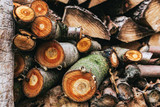Wild Harvesting Pine Pollen on Seattle's City Streets
Wild-Harvesting Pine Pollen
Today, while walking down the busy streets of Seattle, we came across a towering pine tree that caught our attention. Upon closer inspection, we noticed that the tree was full of pollen-bursting catkins, which piqued our curiosity. As avid herbalists and enthusiasts of natural remedies, we decided to take advantage of the opportunity and wild-harvested about a pound of catkins from the pine tree.
We plan on using the Pine Pollen contained in these catkins to make a variety of herbal remedies, including tincture and face cream, which we're excited to experiment with. Not only is the process of creating these remedies enjoyable, but it also helps us connect with nature and appreciate the healing properties that the Earth provides us with.
This serves as a great reminder that even in the hustle and bustle of the city, one can still connect with nature and explore the wild and uncultivated plant world, albeit through a small window in the vast urban landscape. It is important to make sure that whatever you plan to consume or apply to your body comes from a relatively uncontaminated source. While it may be challenging to find such a place in a city like New York, Seattle is fortunate to have an abundance of wild spaces within city limits and pristine air blowing in from the Puget Sound. Seattle's parks and green spaces are home to a rich diversity of flora and fauna, making them perfect for foraging and wild-harvesting medicinal plants, mushrooms, and wild functional foods.
Pine Pollen is a versatile natural remedy in traditional Chinese medicine, being used to relieve (Buhner, 2007):
- Acne
- Diaper rash
- Eczema
- Impetigo
- Stop bleeding
- Arrest discharge (as first aid)
Moreover, it has many other potential benefits. Pine Pollen contains a range of antioxidants and anti-inflammatory compounds that help protect against oxidative stress and reduce inflammation in the body.
In addition, Pine Pollen can be used as a general face cream because it nourishes the body and is excellent for many skin problems. It contains a variety of nutrients, such as vitamins A, B, C, D, and E, as well as minerals like zinc and magnesium, which can help support healthy skin. In fact, Pine Pollen is commonly used in China as an anti-aging mask, making it a fantastic choice for anyone looking to improve their skin's appearance.
We are excited about the potential topical use of Pine Pollen, which has tremendous benefits for skin health. Our plan is to use this wild Pine Pollen to create medicines for ourselves and our friends. Currently, we are starting a folk tincture with this pollen!
Recent Posts
Understanding Our Forest Aurum Pine Pollen Nectar Tincture
Unlocking the Potency of Pine Pollen Forest Aurum Pine Pollen Nectar Tincture represents the c...
Unlocking the Secrets of Tongkat Ali: Tradition, Authenticity, and the Power of Natural Healing
Tongkat Ali: A Beacon of Authenticity in the World of Herbal Medicine In our quest to recover o...
Building Product Stacks and Cycles
Unlocking the Intricacies of Stacking, Combining, and Cycling Herbs and Products for Optimum Benefit...
Unlocking the Vital Role of Estradiol in Male Sexual Health: Looking Beyond Testosterone
Exploring the Complex Interplay of Estradiol and Androgens in Male Sexual HealthBeyond the Shadows o...
Witches' Qi Elixir: Eleven Cauldron Flavors
All Hallows Evening: Celebrating Growth, Death, Renewal, and the Mystical Cycles Eleven Cauldron...
Unstandardized Extracts
A Dedication to Excellence Over Quantity In the upcoming week, we are thrilled to reintroduce a...






